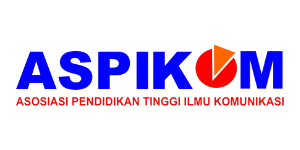Lark: As a Medium of Interpersonal Communication for TNS Employees to Manage Work Stress Amidst the Covid-19 Pandemic
DOI:
https://doi.org/10.37535/105003120244Keywords:
Lark, Computer-Mediated Communication, Social Information Processing Theory (SIPT), Work from home, Work Stress, Covid-19 PandemicAbstract
Working from home (WFH) during the community activity restrictions period (PPKM), such as those imposed by Indonesia’s government, leaves employees with little choice in dealing with work stress. Lark is a collaborative working media tool, during work from home all communication in TNS department took place in Lark. This study's importance is to see how Lark basically a formal working media tool can form an interpersonal communication between woman employees that help them to manage work stress during WFH and PPKM period. Since the trend of working from home is likely to continue even after pandemic, this research provides contribution and information related to communication tools and work from home consequences. The theory for this research is Computer-mediated Communication and Social Information Processing Theory (SIPT). This research method employs a qualitative approach through participant observation, in-depth interviews, and library study. This study finds that implementing WFH during the Covid-19 period resulted in heightened work stress among female employees in TNS Department. It was observed that sharing work-related burdens with coworkers proved to be effective in reducing work stress. Interestingly, sharing with a coworker was considered more beneficial than sharing with a spouse or family. Lark application which serves as a working media tool turns out can facilitate interpersonal communication among female employees. The application's instant messenger, phone call, and expressive emoji make it convenient for employees to share their concerns and stress, as compared to using video conferences.
References
Asbari, M., Cahyono, Y., Fahlevi, M., Purwanto, A., Mufid, A., Agistiawati, E., & Suryani, P. (2020). Impact of Work From Home (WFH) on Indonesian Teachers Performance During the Covid-19 Pandemic : An Exploratory Study. International Journal of Advanced Science and Technology, 29(5), 6235–6244. https://www.researchgate.net/publication/341413246
Bahney, A. (2020, March 17). How to work from home with kids (without losing it) | CNN Business. CCN.Com. https://edition.cnn.com/2020/03/16/success/working-from-home-with-kids-coronavirus/index.html
Bailliencourt, J. de. (2023). Helping creators understand our rules with refreshed Community Guidelines | TikTok Newsroom. Newsroom Tiktok. https://newsroom.tiktok.com/en-us/community-guidelines-update
Bastoni, S., Wrede, C., Ammar, A., Braakman-Jansen, A., Sanderman, R., Gaggioli, A., Trabelsi, K., Masmoudi, L., Boukhris, O., Glenn, J. M., Bouaziz, B., Chtourou, H., & van Gemert-Pijnen, L. (2021). Psychosocial effects and use of communication technologies during home confinement in the first wave of the covid-19 pandemic in Italy and the Netherlands. International Journal of Environmental Research and Public Health, 18(5), 1–12. https://doi.org/10.3390/ijerph18052619
Berger, C. R., & Roloff, M. E. (2019). Interpersonal communication. An Integrated Approach to Communication Theory and Research, Third Edition, 277–291. https://doi.org/10.4324/9780203710753-24
Buffer & Angellist. (2020). Buffer | State Of Remote Work 2020. https://buffer.com/state-of-remote-work/2020
Candrasari, Y. (2020). Mediated Interpersonal Communication: A New Way of Social Interaction in the Digital Age. 423(Imc 2019), 537–548. https://doi.org/10.2991/assehr.k.200325.041
Carr, C. T. (2021). Computer-mediated communication : a theoretical and practical introduction to online human communication. Rowman & Littlefield.
Choi, M., & Choung, H. (2021). Mediated communication matters during the COVID-19 pandemic: The use of interpersonal and masspersonal media and psychological well-being. Journal of Social and Personal Relationships, 38(8), 2397–2418. https://doi.org/10.1177/02654075211029378/ASSET/IMAGES/LARGE/10.1177_02654075211029378-FIG5.JPEG
Creswell, J. W. (2013). Qualitative Inquiry and Research Design Choosing Among Five Approaches (L. Habib (ed.); Third Edit). SAGE Publications Ltd.
Das, A., & Banerjee, K. (2021). Importance of Virtual Interpersonal Communication on Employee Motivation During Covid-19 Pandemic: An Exploratory Study on Women College Teachers in Kolkata, West Bengal. Parikalpana: KIIT Journal of Management, 17(1), 23. https://doi.org/10.23862/kiit-parikalpana/2021/v17/i1/209015
Dehkordi, M. A., Yonekura, S., & Khansefid, N. (2012). Communication Media in SMEs: Measuring Adaptation Factor Using Mixed Method Paradigm. J Telecommun Syst Manage, 1, 103. https://doi.org/10.4172/2167-0919.1000103
DeVito, J. A. (2016). The International Communication Book Fundamental Edition. Pearson Education.
Febrianty, Hadiwijaya, H., & Sentanu, I. G. E. P. S. (2021). Effects of WFH (Work From Home) Policies, Perceived Organizational Support, Job Stress, and the Ability to Use Technology on Lecturer Performance During the New Normal. Proceedings of the 3rd Annual International Conference on Public and Business Administration (AICoBPA 2020), 191(AICoBPA 2020), 263–271. https://doi.org/10.2991/aebmr.k.210928.052
Flick, U. (2014). The Sage Handbook of Qualitative Data Analysis (K. Metzler (ed.)). SAGE Publications Ltd.
Fudian, F., & Oktavianti, R. (2021). The Uses of Computer-Mediated Communication Video Conference in Meeting the Needs of Interaction with Peers During Covid-19 Pandemic. Proceedings of the International Conference on Economics, Business, Social, and Humanities (ICEBSH 2021), 570(Icebsh), 705–710. https://doi.org/10.2991/assehr.k.210805.111
Galanti, T., Guidetti, G., Mazzei, E., Zappalà, S., & Toscano, F. (2021). Work from home during the COVID-19 outbreak: The impact on employees’ remote work productivity, engagement, and stress. Journal of Occupational and Environmental Medicine, 63(7), E426–E432. https://doi.org/10.1097/JOM.0000000000002236
Gesselman, A. N., Ta, V. P., & Garcia, J. R. (2019). Worth a thousand interpersonal words: Emoji as affective signals for relationship-oriented digital communication. PLoS ONE, 14(8), 1–14. https://doi.org/10.1371/journal.pone.0221297
Hadi, A., Asrori, A., & Rusman, R. (2021). Penelitian Kualitatif, Studi fenomenologi, Case Study, Grounded Theory, Etnografi, Biografi. CV Pena Persada.
Holmes, D. (2005). Communication theory: Media, technology, society. In Communication Theory: Media, Technology, Society. https://doi.org/10.4135/9781446220733
Humas UM Sumbar. (2023). Kecepatan Internet Indonesia Peringkat Terakhir di Asia Tenggara. Umsb.Ac.Id. https://umsb.ac.id/berita/index/1102-kecepatan-internet-indonesia-peringkat-terakhir-di-asia-tenggara
Ipsen, C., Veldhoven, M. Van, & Kirchner, K. (2021). Six Key Advantages and Disadvantages of Working from Home in Europe during COVID-19. International Journal of Environmental Research and Public Health.
Joy, P. (2020). Work from home is making 67% Indians suffer from sleep deprivation, says study - Times of India. Indiatimes.Com. https://timesofindia.indiatimes.com/life-style/relationships/work/work-from-home-is-making-67-indian-suffer-from-sleep-deprivation-says-study/articleshow/75126242.cms
Kelsey, S., & Amant, K. St. (2010). Handbook of Research on Computer Mediated Communication. In K. Klinger, K. Roth, J. Neidig, J. Snavely, C. Coulson, K. Smalley, & L. Ehrhardt (Eds.), Handbook of Research on Computer Mediated Communication: Vol. I (1st ed.). IGI Global. https://doi.org/10.1002/asi.21328
King, J., Halversen, A., Morrow, O., Westhoff, W., & Brubaker, P. (2023). Communicating About Mental Health During a Pandemic: An Examination of Active and Aware Publics on Twitter. International Journal of Communication, 17, 631–648. https://ijoc.org/index.php/ijoc/article/view/17593
Király, O., Potenza, M. N., Stein, D. J., King, D. L., Hodgins, D. C., Saunders, J. B., Griffiths, M. D., Gjoneska, B., Billieux, J., Brand, M., Abbott, M. W., Chamberlain, S. R., Corazza, O., Burkauskas, J., Sales, C. M. D., Montag, C., Lochner, C., Grünblatt, E., Wegmann, E., … Demetrovics, Z. (2020). Preventing problematic internet use during the COVID-19 pandemic: Consensus guidance. Comprehensive Psychiatry, 100, 152180. https://doi.org/10.1016/J.COMPPSYCH.2020.152180
Klopotek, M. (2017). The advantages and disadvantages of remote work from the perspective of young employees. Organization & Management Quarterly, Maria Curie-Sklodowska University, 40(4), 38-49. https://cejsh.icm.edu.pl/cejsh/element/bwmeta1.element.baztech-ed42d0c6-5898-4b3b-a46e-f3ded21414c4
Lee, T. K., Moon, H. W., & Kim, J. S. (2022). The effects of workers’ job stress on organizational commitment and leaving intention in commercial sports centers. Journal of Exercise Rehabilitation, 18(5), 294. https://doi.org/10.12965/JER.2244438.219
Lee, Y. C., Malcein, L. A., & Kim, S. C. (2021). Information and communications technology (ICT) usage during COVID-19: Motivating factors and implications. International Journal of Environmental Research and Public Health, 18(7). https://doi.org/10.3390/IJERPH18073571/S1
Liu, D., Baumeister, R. F., Yang, C. C., & Hu, B. (2019). Digital communication media use and psychological well-being: A meta-analysis. Journal of Computer-Mediated Communication, 24(5), 259–274. https://doi.org/10.1093/ccc/zmz013
Luo, Z., & Walden, J. (2019). Fundamental Changes brought by Computer-mediated Communication. In S. Kelly (Ed.), Computer-Mediated Communication for Business (p. 262). Cambridge Scholar.
Luthans, F. (2011). Organizational Behavior An Evidence-Based Approach. In McGraw-Hill/Irwin (Twelfth Ed). McGraw-Hill/Irwin. https://doi.org/10.5005/jp/books/10358_23
Meier, J. V., Noel, J. A., & Kaspar, K. (2021). Alone Together: Computer-Mediated Communication in Leisure Time During and After the COVID-19 Pandemic. Frontiers in Psychology, 12(June). https://doi.org/10.3389/fpsyg.2021.666655
Muhyiddin, M., & Nugroho, H. (2021). A Year of Covid-19: A Long Road to Recovery and Acceleration of Indonesia’s Development. Jurnal Perencanaan Pembangunan: The Indonesian Journal of Development Planning, 5(1), 1–19. https://doi.org/10.36574/JPP.V5I1.181
Mungkasa, O. (2020). Bekerja dari Rumah ( Working From Home / WFH ): Menuju Tatanan Baru Era Pandemi COVID 19 Bekerja dari Rumah ( Working From Home / WFH ): Menuju Tatanan Baru Era Pandemi COVID 19. The Indonesian Journal of Development Planning, IV(2), 126–150.
Neuman, W. L. (2007). Basics of Social Research Qualitative and Quantitative Approaches. In J. Lasser, E. Adams, K. May, & R. Sherman (Eds.), Pearson Education (Second Edi, Vol. 6, Issue August). Pearson Education.
Olaniran, B. A., Rodriguez, N., & Williams, I. M. (2011). Social information processing theory (SIPT): A cultural perspective for international online communication environments. Computer-Mediated Communication across Cultures: International Interactions in Online Environments, January 2011, 45–65. https://doi.org/10.4018/978-1-60960-833-0.ch004
Pang, A., Shin, W., Lew, Z., & Walther, J. B. (2018). Building relationships through dialogic communication: Organizations, stakeholders, and computer-mediated communication. Journal of Marketing Communications, 24(1), 68–82. https://doi.org/10.1080/13527266.2016.1269019
Petricini, T. (2022). Friendship and Technology A Philosophical Approach to Computer-Mediated Communication (1st ed.). Routledge Taylor & Francis Group.
Putri, A., & Oktaviani, R. C. (2022). Communication Planning: A Tool for Behavior Change. Journal of Communication and Public Relations, 2(1), 24–32. https://doi.org/10.37535/105002220233
Putri, A. V., & Irwansyah, I. (2020). Communication Patterns and Media Technology Role in Organization and Society During Pandemic. The Journal of Society and Media, 4(2), 228. https://doi.org/10.26740/jsm.v4n2.p228-261
Reddy, B. V., & Gupta, A. (2020). Importance of effective communication during COVID-19 infodemic. Journal of Family Medicine and Primary Care, 9(8), 3793. https://doi.org/10.4103/JFMPC.JFMPC_719_20
Sahni, D. J. (2020). Impact of COVID-19 on Employee Behavior: Stress and Coping Mechanism During WFH (Work From Home) Among Service Industry Employees. International Journal of Operations Management, 1(1), 35–48. https://doi.org/10.18775//ijom.2757-0509.2020.11.4004
Satgas Covid-19. (2022). Informasi terbaru seputar penanganan COVID-19 di Indonesia oleh Pemerintah. | Covid19.go.id. Covid19.Go.Id. https://covid19.go.id/id
Shabuur, M. I., & Mangundjaya, W. L. (2021). Pengelolaan Stres dan Peningkatan Produktivitas Kerja selama Work From Home pada Masa Pandemi COVID-19. Jurnal Psikologi Udayana, 7(2), 93. https://doi.org/10.24843/jpu.2020.v07.i02.p09
Smith, J. A., Flowers, P., & Larkin, M. (2009). Interpretative Phenomenological Analysis Theory, Method, and Research. Sage Publications, Inc.
Sugiyono, S. (2013). Metode Penelitian Kuantitif Kualitatif dan R&D. Alfabeta.
Thanh, N. C., & Thanh, T. T. Le. (2015). The Interconnection Between Interpretivist Pardigm and Qualitative Methods in Education. American Journal of Educational Science, 1(2), 24–27. http://files.aiscience.org/journal/article/html/70380008.html
Treem, J. W., Leonardi, P. M., & Van Den Hooff, B. (2020). Computer-Mediated Communication in the Age of Communication Visibility. Journal of Computer-Mediated Communication, 25(1), 44–59. https://doi.org/10.1093/jcmc/zmz024
UN Women. (2020). New UN Report Unveils the Heavy Toll on Women and Girls Left Behind During COVID-19 | UN Women – Asia-Pacific. In unwomen.org. https://asiapacific.unwomen.org/en/news-and-events/stories/2020/10/new-un-report-unveils-the-heavy-toll-on-women-and-girls-left-behind-during-covid-19
Valo, M., & Mikkola, L. (2019). Focusing on workplace communication. Workplace Communication, January 2022, 3–14. https://doi.org/10.4324/9780429196881-1
Venter, E. (2019). Challenges for meaningful interpersonal communication in a digital era. HTS Teologiese Studies / Theological Studies, 75(1), 1–6. https://doi.org/10.4102/hts.v75i1.5339
Vertino, K. A. (2014, September). Effective Interpersonal Communication: A Practical Guide to Improve Your Life | OJIN: The Online Journal of Issues in Nursing. OJIN The Online Journal of Issues in Nursing. https://ojin.nursingworld.org/table-of-contents/volume-19-2014/number-3-september-2014/effective-interpersonal-communication/
Vyas, L., & Butakhieo, N. (2021). The impact of working from home during COVID-19 on work and life domains: an exploratory study on Hong Kong. Policy Design and Practice, 4(1), 59–76. https://doi.org/10.1080/25741292.2020.1863560
Walther, J. B. (1992). Interpersonal Effects in Computer-Mediated Interaction: A Relational Perspective. Communication Research, 19(1), 52–90. https://doi.org/10.1177/009365092019001003
Walther, J. B., Loh, T., & Granka, L. (2005). Let me count the ways the interchange of verbal and nonverbal cues in computer-mediated and face-to-face affinity. Journal of Language and Social Psychology, 24(1), 36–65. https://doi.org/10.1177/0261927X04273036
Wolor, C. W., Dalimunthe, S., Febrilia, I., & Martono, S. (2020). How to Manage Stress Experienced by Employees When Working from Home Due to the Covid-19 Virus Outbreak. International Journal of Advanced Science and Technology, 29(5), 8359–8364.
Wood, J. T. (2008). Communication In Our Lives Fifth Edition. In M. Eckman, G. Lleaud, & K. Gengler (Eds.), Wadsworth Cengage Learning (5th ed.). Wadsworth Cengage Learning.
World Health Organization. (2022). WHO Coronavirus (COVID-19) Dashboard | WHO Coronavirus (COVID-19) Dashboard With Vaccination Data. WHO Health Emergency Dashboard. https://covid19.who.int/
Wowor, H. A. F., & Putri, K. Y. S. (2021). Komunikasi Interpersonal Keluarga sebagai Penunjang Kesehatan Mental Mahasiswa Rantau Asal Papua-Papua Barat. Perspektif, 11(1), 205–213. https://doi.org/10.31289/perspektif.v11i1.5488
Yao, M. Z., & Ling, R. (2020). “What Is Computer-Mediated Communication?”—An Introduction to the Special Issue. Journal of Computer-Mediated Communication, 25(1), 4–8. https://doi.org/10.1093/jcmc/zmz027
Yuliana, R., & Rahadi, D. R. (2021). Komunikasi Interpersonal Dalam Meningkatkan Motivasi Karyawan Di Masa Pandemi Covid-19. Magisma: Jurnal Ilmiah Ekonomi Dan Bisnis, 9(1), 27–35. https://doi.org/10.35829/magisma.v9i1.133
Yunus, U. (2023). Branding Yourself Through Interpersonal Communication (X. A. Wijayanto (ed.)). LP3M LSPR Publishing. https://omp.lspr.edu/index.php/omp/catalog/book/19
















